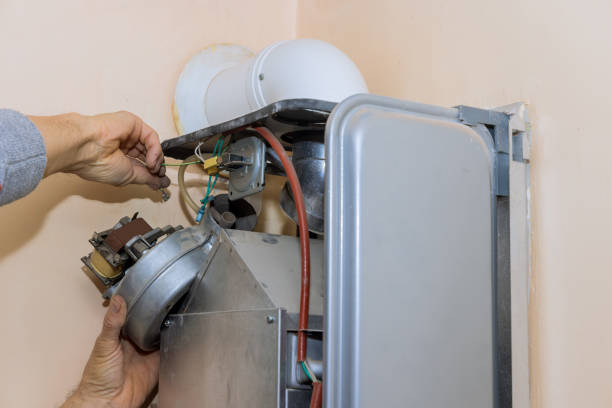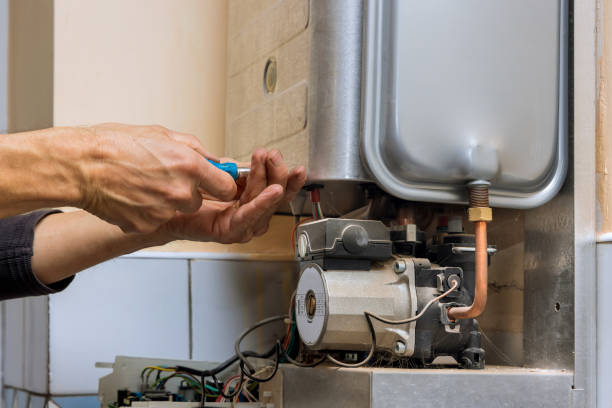Expansion vessels are a vital component of any combi boiler system, as they help regulate the pressure and volume of fluid or gas inside the system. However, over time, expansion vessels can become faulty and require recharging to function correctly.
Here, we look at when an expansion vessel recharge will be needed and explain are some common symptoms of a faulty expansion vessel to help you recognize when it’s time for a recharge.
Recharging an expansion vessel is a simple maintenance task that can extend the life of your boiler and ensure it operates efficiently.
Understanding Expansion Vessels in Boilers
An expansion vessel is a container that holds a volume of air and water, with a rubber diaphragm allowing it to expand and contract as the temperature and pressure change within the boiler system.
Usually rectangular in shape for combi boilers, it helps to absorb any changes in the pressure and temperature of the system, ensuring the correct operation of the boiler and preventing damage to pipes, valves, and other components.

Signs of a faulty expansion vessel
One of the most common signs of a faulty expansion vessel is when it becomes full of water. This occurs when the rubber diaphragm inside the vessel becomes damaged or ruptured, allowing water to enter the vessel and replace the air inside.
Without air, the expansion vessel cannot perform its function of absorbing excess pressure, which can cause boiler pressure issues and even lead to leaks or boiler breakdowns.
Others signs of a faulty expansion vessel can include:
- Fluctuating pressure. If the pressure in the system is fluctuating, this could be a sign that the expansion vessel is not functioning correctly. It cannot absorb excess pressure, causing the boiler pressure to increase and potentially damage the system.
- Leaks. If you notice any leaks in the system, this could be a sign of a faulty expansion vessel.
- Noisy system. If you hear unusual noises, such as hissing or whistling, coming from the system, this could be a sign of a faulty expansion vessel.
- Poor heating performance. If the heating performance of the system is poor or the system is not working at all, this could be a sign of a faulty expansion vessel.
Tools required to recharge an expansion vessel
To recharge an expansion vessel in a boiler, you will need the following tools:
- A pressure gauge: to measure the pressure in the system and to ensure that the correct pressure is maintained.
- A Schrader valve tool: to access the valve on the expansion vessel, which is used to add or remove air from the system.
- A bicycle pump or a compressor: to add air to the system if needed.
- An adaptor to connect the pump to the correct valve type.
- A bleed key: to release any air from the system if needed.
It is important to use the correct tools to recharge the expansion vessel, as using the wrong tools or incorrect techniques can damage the system. If you are unsure how to recharge the expansion vessel, it is best to consult the manufacturer’s manual or a professional heating engineer.
Combi Boiler Expansion Vessel Recharge Steps
To recharge the expansion vessel in a combi boiler, you need to follow these steps:
- Turn off the power and water supply to the boiler. Practice safe electrical isolation procedures and also close off the flow and return valves to isolate the water. If you have a magnetic filter, you can use that to isolate the water.
- Locate the expansion vessel and identify the air valve. This is accessible in different ways depending on the boiler manufacturer. Other components might need to be moved or removed to access the valve. The valve can be located either on the top or the side of the vessel.
- Use a pressure gauge to check the current pressure. Check with manufacturer’s instructions for the correct level.
- Pump air. If the pressure is below the recommended level, usually 1 mbar, add air using an air pump until it reaches the correct pressure
- Repeat the pressure check. Adjust as necessary.
- Test the valve is closed tight after recharging. You could spray leak detector fluid on the valve to test it. Make sure to wipe it clean after.
- Turn the water and power supply back on.
- Refill the system to the correct pressure. Check for leaks around the boiler. Also check the radiators in the house and bleed them if necessary.

Avoid these when recharging the expansion vessel
When attempting to recharge an expansion vessel in a boiler, it is important to avoid the following mistakes:
- Overcharging or undercharging the system: Overcharging the system can cause damage to the components, while undercharging can result in the system not functioning correctly.
- Releasing too much air from the system: This can cause the pressure to drop too low and damage the system.
- Releasing pressure by opening the pressure relief valve (PRV). This can cause dirt in the system water to get stuck in the PRV, so it doesn’t seal properly again.
- Failing to turn off the electricity supply: Turning off the electricity supply is important to avoid electrical shock while working on the system.
- Ignoring leaks or other damage: If you notice any leaks or other damage to the system, it is important to repair them before attempting to recharge the expansion vessel.
Conclusion
Recharging the expansion vessel in your boiler is a simple maintenance task that can extend the life of your boiler and ensure it operates efficiently. By following these steps, you can easily recharge the expansion vessel in a combi, system, or conventional boiler. If you are unsure about the process or have any concerns, it is always best to consult a professional heating engineer.
